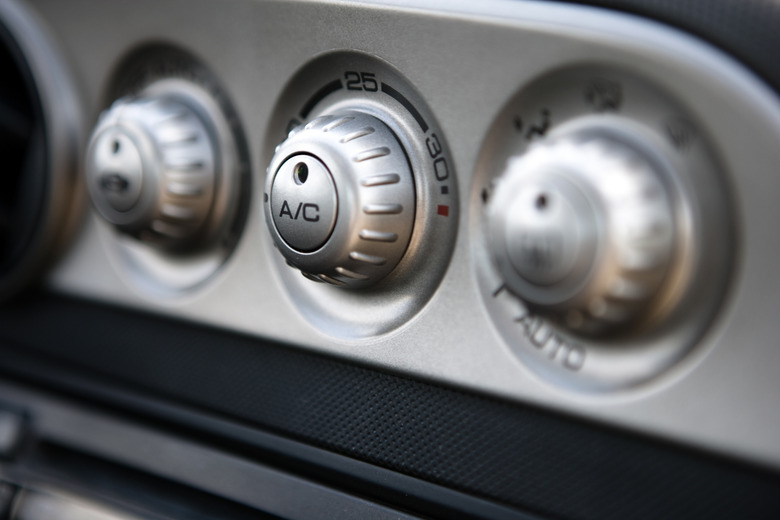How To Make A Solar-Powered Air Conditioner
Using solar energy to provide cool air can be as high-tech and elaborate as mounting solar panel arrays to power conventional air conditioners or as simple as Bronze Age technology used by Middle Eastern kings to cool their palaces. The following design is a proof of the concept of the latter, which you may readily adapt to your own location.
Step 1
Dig a trench 10.5 feet long, 4 inches wide and 2.5 feet deep. The best experiment will involve one end being in shade and the other end of the trench seeing full sunlight.
Step 2
Drill a three-inch hole (using power drill and hole saw bit) near one side of the bottom of the wooden crate and a second hole in the top of the crate, offset from the bottom hole by several inches.
Step 3
Cut one of the 10-foot lengths of PVC pipe into one 4-foot and two 3-foot sections, using the hack saw, tape measure and marker.
Step 4
Prime the inside ends of the 90-degree PVC elbows, both outer ends of the remaining 10-foot pipe section and one outer end of each 3-foot section. Apply the primer and allow to dry in a well-ventilated location.
Step 5
Glue a 90-degree elbow to each end of the 10-foot section of PVC pipe, making sure to position the elbows so the open ends are parallel to each other (pointing the same direction).
Step 6
Glue a 3-foot section of PVC pipe into each of the open ends of the elbows.
Step 7
Place the glued pipe into the trench and bury with approximately six inches extending above ground at each end.
Step 8
Set the crate over the pipe extending up from the trench at the sun-exposed end, placing the hole in the crate bottom over the pipe and leaving the pipe open end inside the crate.
Step 9
Paint the top of the crate (and optionally the sides) with the gloss white paint (or aluminum paint or cover with heavy duty aluminum foil, shiny side out).
Step 10
Glue the remaining (4-foot section) PVC pipe into the top hole of the crate.
Step 11
Paint the "chimney" (the pipe coming from the top of the crate) with the flat black paint.
Step 12
Drill (using power drill and bit sized for the thermometers) mounting points for the thermometers at the input (shaded side PVC pipe coming from the ground), one into any side of the crate and one near the top of the crate chimney pipe.
Step 13
Insert the dial-faced thermometers into the mounting holes.
Step 14
Record the results, contrasting the temperature of the input port (in the shade), inside the crate and at the chimney pipe. As the chimney absorbs solar energy, the air inside will heat and escape through the end of the chimney. Warm air at the top of the crate will replace it, causing a pressure draw to pull air through the buried pipe. Air drawn through the buried pipe will be cooled as it flows through the cool ground.
The cycle of cool air, cooled further as it passes underground and is drawn into the crate to replace warm air drawn out by heat convection, will bring the temperature inside the crate to a point lower than the input air.
This concept may be expanded to cooling outdoor sheds or garages at no electrical cost after installation.
Things Needed
- Wooden crate (for example, 4 ft X 4 ft X 5 ft oven-shipping crate)
- Shovel
- PVC pipe, 3" diameter, 20 ft length (in two10-ft sections for easier transport)
- Hack saw
- Tape measure
- Marker
- 2 PVC 90-degree elbows, 3" diameter
- PVC primer
- PVC glue
- Gloss white or shiny aluminum paint (or roll of heavy duty aluminum foil)
- Flat black paint
- 3 dial-face thermometers reading up to 200 degrees F (or more)
- Drill bit to match diameter of thermometer probe
- 3" hole saw bit
- Power drill
TL;DR (Too Long; Didn't Read)
A deeper trench will result in cooler air.
Multiple input pipes will give a cooler crate as the cooling load is spread and the air flow in each pipe is reduced (allowing more time for the ground to cool the air passing through it).
Warning
Caps at the input pipe and chimney are needed to keep rain from filling the pipe or dropping into the crate.
Cite This Article
MLA
Donahue, Christopher. "How To Make A Solar-Powered Air Conditioner" sciencing.com, https://www.sciencing.com/make-solarpowered-air-conditioner-5948825/. 24 April 2017.
APA
Donahue, Christopher. (2017, April 24). How To Make A Solar-Powered Air Conditioner. sciencing.com. Retrieved from https://www.sciencing.com/make-solarpowered-air-conditioner-5948825/
Chicago
Donahue, Christopher. How To Make A Solar-Powered Air Conditioner last modified March 24, 2022. https://www.sciencing.com/make-solarpowered-air-conditioner-5948825/
